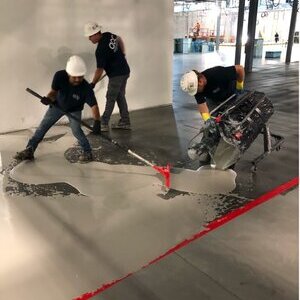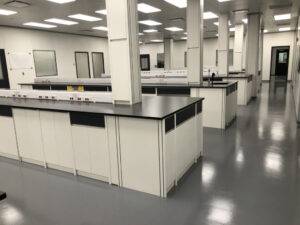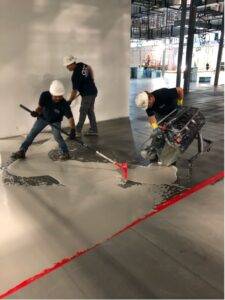What Is Resinous Flooring
by Tom Cramsie
Resin flooring (commonly referred to as “epoxy flooring”) has been used for decades in a variety of commercial and residential settings due to its durability, wide range of system choices and color options and longevity.
Resinous coatings (commonly referred to as “epoxy” coatings) can be found in many commercial and industrial flooring applications. Typically applied over concrete, resinous flooring provides a high-performance, smooth or textured, durable surface that can last many years while withstanding heavy loads and traffic. Many industrial, warehouse, retail, grocery, educational, pharmaceutical and medical facilities rely on epoxy floors to maintain clean and safe conditions for staff, equipment, and inventory. Epoxy flooring systems can also be found in residential settings from garages to basements and game rooms.
What is Epoxy?
Epoxy is an adhesive, paint, plastic, or other material that is created as a polymer of epoxides. The term “epoxy” is used to describe coatings that are created from mixing two different chemicals together, referred to as “resin.” This classifies epoxy as a copolymer. Think of epoxy as liquid plastic that becomes very hard as it dries (cures).
There are many benefits that come with using an epoxy floor coating. Most importantly, epoxy is known to be the highest strength resin commonly available. Epoxy is typically chosen for its excellent mechanical properties and dimensional stability. When properly cured, epoxy flooring provides superior chemical and heat resistance with extremely low shrinkage. Epoxy resins are an excellent option for repairs due to their ability to bond to dissimilar materials. The bonding of epoxy paint offers a strength which cannot be matched by other common materials, such as vinylester or polyester.
What is Epoxy Flooring?
Epoxy is becoming more and more popular as a flooring option in industrial, commercial and residential applications. Epoxy floor coatings are typically made up of two parts: a Part A resin and Part B hardener. The two parts are mixed together in ratios determined by the manufacturer. The most common ratio is 2 parts A:1 part B. Specialty additives such as flow control, UV inhibitors and fast-cure accelerators are added to create coatings that perform in a wide variety of environments. Using these specialty additives, epoxy floor coatings are formulated to achieve different desired performance characteristics like reduced cure time, increased abrasion resistance, higher chemical resistance, higher or lower viscosity, etc. Most epoxies come clear or pre-pigmented, with some manufactures offering tint kits which allow the epoxy to be tinted on-site. Different broadcast mediums like sand, decorative colored quartz or acrylic flakes can be added to the epoxy floor to achieve different performance and aesthetic characteristics.

Applying a Resinous Floor
Surface preparation plays an integral role in allowing the resinous coating to adhere to the concrete. An epoxy coating requires a clean and mechanically profiled surface in order to adhere properly. Most often, the concrete is shot blasted, scarified or diamond ground as a means of cleaning the surface while profiling the concrete. Most resinous coatings call for a concrete surface profile (CSP) level 3-5 in order to adhere properly and meet manufacturer warranty requirements.
Once the concrete is profiled and thoroughly cleaned, repairs are made to divots and/or cracks while control joints can be filled to create a seamless floor. Typically, epoxy flooring systems require multiple layers. A “primer” can be used to penetrate deeply into the concrete and allow for better adhesion of the intermediate, or “body,” coat(s) of epoxy. A finish coat, or “top coat,” of urethane or polyaspartic polyurethane can be applied following the epoxy body coats if additional strength and abrasion resistance is required. For many commercial projects, the architect will specify system requirements based on setting and use.

Once parts A and B are mixed together, a chemical reaction occurs to induce curing. This results in limited working time before the epoxy begins to heat-up and become tacky, making it difficult to work with. Ambient temperatures also play a role in cure rates. Installers need to move a lot quicker on a 90° day versus a 70° day!! Most epoxies are applied with a gauge squeegee which allows the installer to pre-determine the thickness at which the epoxy is applied and ensure an even coat across the surface. Following squeegeeing, the epoxy should be back rolled with a lint-free roller to relieve any squeegee marks. Once the floor has been evenly coated and back rolled, the broadcast medium (sand, quartz, flake, etc.) is thrown into the epoxy if desired.
Pros and Cons of Resinous Floors
The benefits far outweigh the challenges when it comes to resinous floors. Some of the benefits include:
- Visual appearance – Resinous flooring provides a shiny, clean finish which is great for labs, hospitals and commercial buildings. The sealed surface also makes these floors easy to clean, allowing the sheen to last for many years. Once the sheen dissipates, the floors can be sanded and re-topcoated to revitalize the shine.
- Durability – The strong chemical bonds of epoxy floorings make them ideal for high-traffic spaces and facilities with heavy lifting or potentially intensive processes.
- Cost – Epoxy floors are more affordable than many other flooring options. Typical epoxy flooring costs range from $4–20+/sf. Considering their durability and longevity, this results in a lower dollar cost average over time.
- Regulatory approval – Epoxy floors are well-proven in various industries. Both the USDA and FDA have approved resinous floors for use in food and beverage and pharmaceutical processing and distribution facilities.
Smell, moisture, and sensitivity are three main issues encountered when installing resinous floors. Some epoxies have a slight solvent odor; however, this only lasts during the installation process. Moisture from the subsurface can result in delamination of the epoxy. Many primers can help alleviate minor moisture issues. For instances where moisture is known to be a significant issue, a vapor barrier epoxy can be installed. Finally, epoxy can be sensitive to temperature and direct sunlight during installation, both of which can cause bubbles when curing. An experienced installer can get around both of these issues.
The world of resinous flooring is vast. There are an incredible number of systems and options available, with each manufacturer seemingly having their own naming scheme and coatings. While this can be daunting, it also allows for a system to be available for virtually any situation. Whether it be for a hospital or grocery store, an operating room or a restroom, there is a perfectly suited resinous flooring system.
